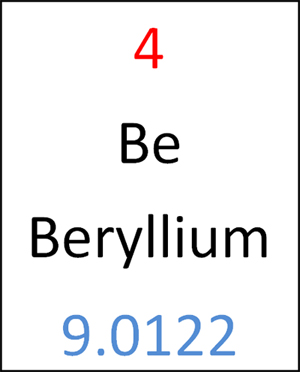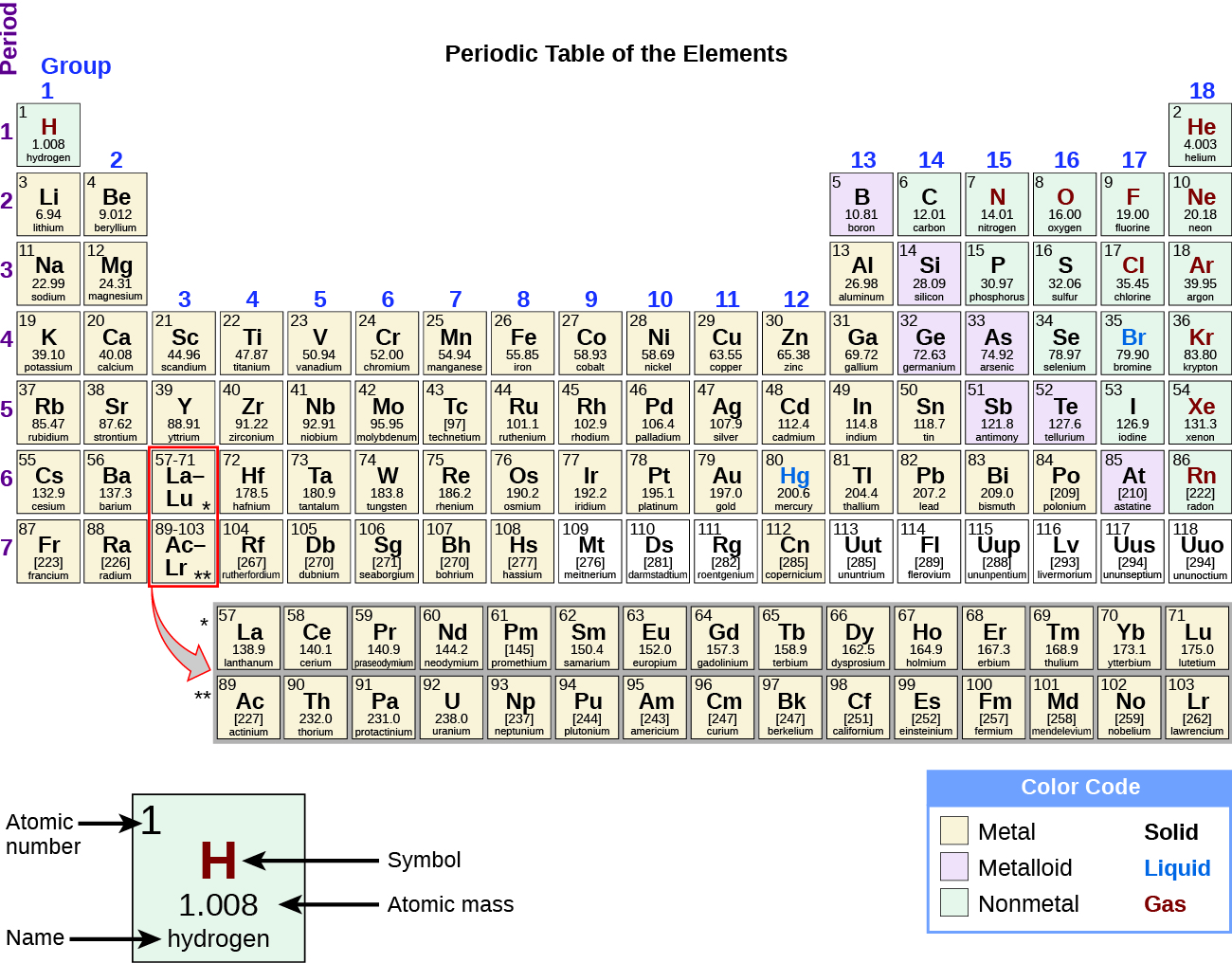Beryllium Atomic Mass
Exact Mass: 10.013535 g/mol: Computed by PubChem 2.1 (PubChem release 2019.06.18) Monoisotopic Mass: 10.013535 g/mol: Computed by PubChem 2.1 (PubChem release 2019.06.18) Topological Polar Surface Area: 0 Ų: Computed by Cactvs 3.4.6.11 (PubChem release 2019.06.18) Heavy Atom Count: 1: Computed by PubChem: Formal Charge: 0: Computed. Beryllium (Be) Atomic Data for Beryllium (Be) Atomic Number = 4 Atomic Weight = 9.01218 Reference E95: Isotope: Mass: Abundance: Spin: Mag Moment: 9 Be: 9.012182: 100%: 3/2-1.1776: 10 Be: 10.013534: Trace: 0: Be I Ground State 1s 2 2s 2 1 S 0 Ionization energy 75192.64 cm.
Beryllium is the element whose atomic number is 4. The beryllium is represented by the symbol Be. The various properties of beryllium are:
PHYSICAL PROPERTIES OF BERYLLIUM:
1. Beryllium exist in nature in solid phase.
2. The density of beryllium is 1.85 g/cm3
3. The melting point of beryllium is 1560 K
4. The boiling point of beryllium is 2742 K
5. The heat of vaporization of beryllium is 297 KJ/mol
CHEMICAL PROPERTIES OF BERYLLIUM:
1. Beryllium is present in various oxidation state like +2 and +1.
2. The electronegativity of beryllium is 1.57 in Pauling scale.
3. The ionization enthalpy of beryllium is as such:
1st ionization enthalpy: 899 KJ/mol
2nd ionization enthalpy: 1757 KJ/mol
3rd ionization enthalpy: 14848 KJ/mol
4. Beryllium is diamagnetic in nature.
5. The crystal structure of beryllium is hexagonal in shape.
Atomic Mass of Beryllium
The atomic mass of Beryllium is 9.01 g/mol. The atomic mass of Beryllium is the sum of the masses of all the electrons, protons and the neutrons. Since, there are 4 electrons present in one atom of Beryllium. Therefore, the number of protons are same in number that is 4 to neutralize the -ve charge of electrons. The rest mass addition is due to the presence of neutrons in the atom. The mass of each electron is 9.1x 10-31 Kg. Mass of each proton is 1.67 x 10-27 Kg. The mass of each neutron is 1.67 x 10 -27 Kg.
-27 Kg.4 x 9.1 x 10-31+ 4 x 1.67 x 10-27 + 4 x 1.67 x 10-27 Kg = 1.33636 x 10-26 Kg = 9.01 g/mol.
The structure and this atomic mass makes the beryllium a useful element for the nuclear processes. The following two reactions shows the nuclear properties of Beryllium:
 (1) 94Be + n → 2(42He) + 2n
(1) 94Be + n → 2(42He) + 2nThsi reaction shows the the behaviour of beryllium to release more neutrons in respect to the number of neutrons absorbed by it.
 (2) 94Be + 42He → 126C + n
(2) 94Be + 42He → 126C + nBeryllium 7 Atomic Mass
This reaction shows the production of neutrons by hitting of Beryllium nuclei with alpha particles.
Uses of Beryllium
The various uses of beryllium are:1. The use of beryllium is to tune the klystrons, magnetrons and travelling wave tubes.
2. Beryllium is used in nuclear weapon design.
3. It used for the manufacture of high frequency speaker drive.
4. It is used as a p-dopent semiconductor material in the electronic industry.
5. The compounds of beryllium are used in the flouroscent tube lights.
Molar mass of BeCl2 = 79.918182 g/mol
This compound is also known as Beryllium Chloride.
Convert grams BeCl2 to moles or moles BeCl2 to grams
Molecular weight calculation:
9.012182 + 35.453*2
Beryllium Number Of Electrons
| Symbol | # of Atoms | Beryllium | Be | 9.012182 | 1 | 11.277% | |
| Chlorine | Cl | 35.453 | 2 | 88.723% |
In chemistry, the formula weight is a quantity computed by multiplying the atomic weight (in atomic mass units) of each element in a chemical formula by the number of atoms of that element present in the formula, then adding all of these products together.
Beryllium Atomic Mass Diagram
Finding molar mass starts with units of grams per mole (g/mol). When calculating molecular weight of a chemical compound, it tells us how many grams are in one mole of that substance. The formula weight is simply the weight in atomic mass units of all the atoms in a given formula.
Formula weights are especially useful in determining the relative weights of reagents and products in a chemical reaction. These relative weights computed from the chemical equation are sometimes called equation weights.
The atomic weights used on this site come from NIST, the National Institute of Standards and Technology. We use the most common isotopes. This is how to calculate molar mass (average molecular weight), which is based on isotropically weighted averages. This is not the same as molecular mass, which is the mass of a single molecule of well-defined isotopes. For bulk stoichiometric calculations, we are usually determining molar mass, which may also be called standard atomic weight or average atomic mass.
If the formula used in calculating molar mass is the molecular formula, the formula weight computed is the molecular weight. The percentage by weight of any atom or group of atoms in a compound can be computed by dividing the total weight of the atom (or group of atoms) in the formula by the formula weight and multiplying by 100.
A common request on this site is to convert grams to moles. To complete this calculation, you have to know what substance you are trying to convert. The reason is that the molar mass of the substance affects the conversion. This site explains how to find molar mass.
Using the chemical formula of the compound and the periodic table of elements, we can add up the atomic weights and calculate molecular weight of the substance.
